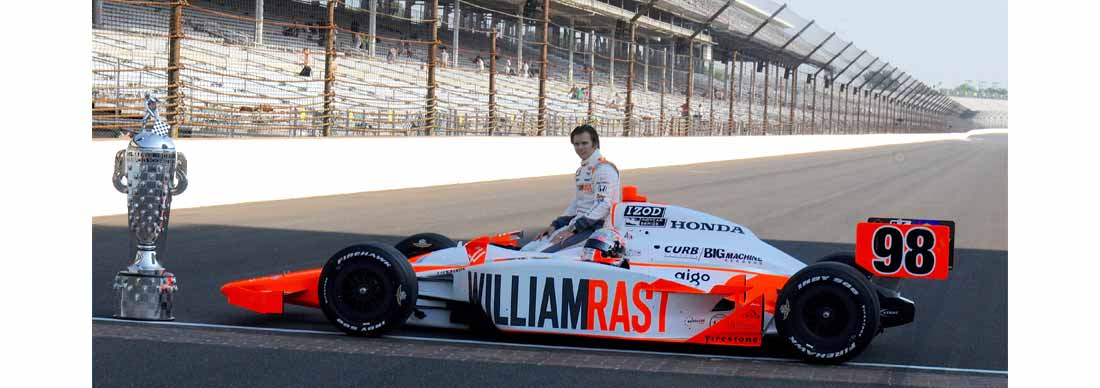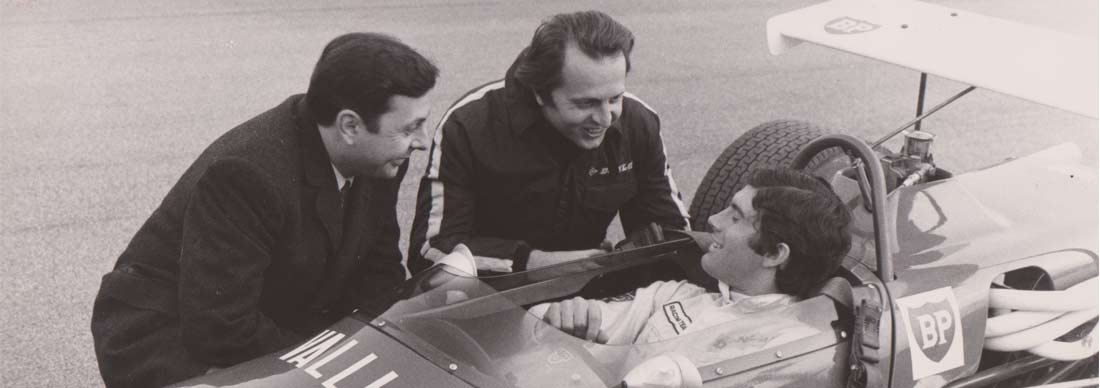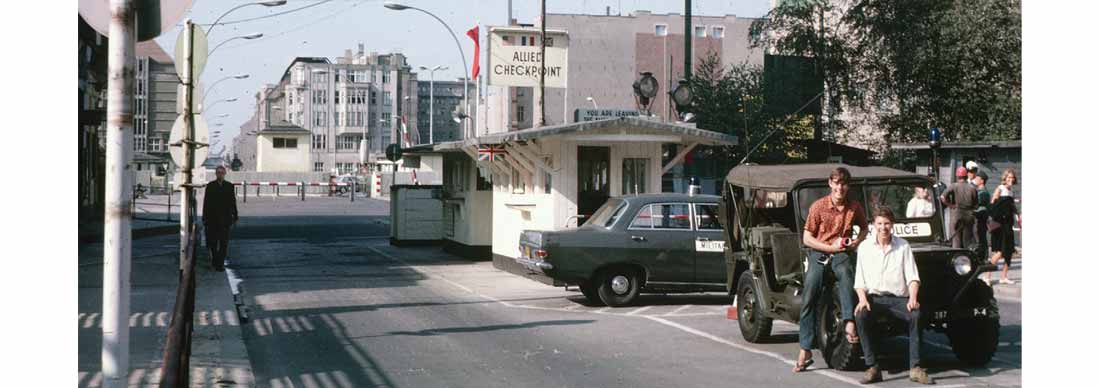
Dan Wheldon, by Ian Wagstaff
From 2005 to 2012, British drivers dominated the results at the Indianapolis 500, winning outright on five occasions. Two of those victories, as well as a pair of seconds, a third and a fourth fell to the late Dan Wheldon. A couple of days after his 2011 win, Dan’s race engineer, Todd Malloy told the writer how they had achieved Victory Circle that year. Tragically, Dan was to die in an accident at the Las Vegas Speedway a few months later.
. . . . .

The Indianapolis Motor Speedway the day after the annual ‘500’ race is a relatively quiet place. The vast majority of the over a quarter of a million crowd has gone home, although a few, perhaps reluctant to let go, have returned to wander through the track’s museum. Over by the ‘yard of bricks’ start line, a group of photographers and journalists gather for the winner’s morning-after photo shoot.
In 2011 there was a little extra zest to the occasion. Despite having now won the Indy 500 twice, Dan Wheldon still retained his boyish enthusiasm and, however much the organisers wanted to move things along, he was doing it his way. Tino Belli, a race engineer at Andretti Green when Wheldon won his first ‘500’, once put it like this, ‘The guy is an Indianapolis natural.’ That applied not only to just the race but everything that went with it. For a lad from Buckinghamshire that was quite something. When he won in 2005, it was the first victory at Indy for a Brit since 1966. Now the ‘500’ had been won by them four times out of the last seven, and in one of the other three Wheldon dominated until a last-minute puncture.
The Las Vegas Speedway is a very different place to the IMS. Unlike the Indiana track with its long straights, it is a conventional oval, just 1.5-miles long. The Mario Andretti Racing School has attempted to give some idea of what it is like to race an IndyCar there. The initial course involves following an instructor who will ensure that you do not exceed 150mph. Driving round, you recall that the ‘real thing’ means close proximity with other cars at an average of well over 200mph, and that you still have no idea of what it must be really like.

This article was written just two days after Dan’s fatal accident, but recriminations had started already about what happened on October 16, 2011. You may have read about those elsewhere and they were easy to say. Perhaps it was just one race too many? Long before that year’s Las Vegas IndyCar race, Dallara designer Andrea Toso had stated that his driving force in creating the next IndyCar would be to have bodywork that prevented interlocking wheels, and wheels riding over the top of each other, factors that were part of the 15-car Las Vegas accident in which Wheldon lost his life. The next IndyCar race, the 2012 season opener at St Petersburg, would feature Toso’s design. It should also have seen Dan on the grid, back with one of the top teams. He was due to replace Danica Patrick at Andretti Autosport.
A career that had taken a dip was undoubtedly being revived.
Back in 1946, another British-born driver George Robson won the Indianapolis 500 and was killed in a race at the end of the season. Robson was hardly known in the land of his birth. Until Las Vegas, the same could arguably be said of Wheldon, the UK media preferring to talk about a British tennis player who has not won the US Open once, rather than a Briton who had taken America’s greatest motor race twice, as well as the 2005 IndyCar Championship. There were, though, those amongst his compatriots who realised his worth.
Following his final-bend victory in the 2011 Indianapolis 500, Wheldon noticed the members of ‘Brit Corner’ – Indy’s answer to the ‘Barmy Army’ - on the edge of Victory Circle. Elated, he raced over to embrace their leader, Nick Garside. ‘He was our mate and hero,’ said Garside. It is what you remember about Dan Wheldon – his enthusiasm.
Much has been written about Dan’s attributes; perhaps a fitting tribute would be to recall his final victory, the 2011 Indianapolis 500, not through his eyes but those of his race engineer, Todd Malloy, recalled a few days later in a spartan office at Bryan Herta Autosport.

The entry was a one-off, an alliance with Sam Schmidt Motorsports to run three cars. It had to be something different to take on the IndyCar series regulars. Malloy reminisced, ‘It started off well because Dan was fourth right off the start. The first part of the race was straightforward: we gained some positions and ran behind the Ganassi cars. It seemed that, of the three-car group we were mainly part of, we were the better over the long run. The car was not perfect. We had to add some front wing during the first couple of stops. Dan wanted to stay as fast in traffic as he could, in order to line up to pass, so he wanted the balance as good as possible behind other cars. Initially, we had too much understeering in the dirty air; the car was too light when the tyres got old. Later, we added a bit more wing, probably too much. Mid-to-later in the race we had a couple of restarts that weren’t “super good”. Dan is excellent at restarts, but I think we may have gone a bit too far on the centre of pressure, which made it a little harder on the cold tyres.’
For the first time, double-file restarts had been employed in the '500', a controversial move. ‘[These] were a big factor in the race,’ recalled Malloy. ‘Early on, when we were at the “pointy” end it wasn’t a big deal, but once you get shuffled back to sixth or seventh position, then you are effectively further back because there are three or four lapped cars mixed up there. It turned into a bit of a free-for-all, which could turn out great or badly. TK (Tony Kanaan) put a nasty block on Dan and somebody also hit him in the rear. For several years Indianapolis has been a track position race. If you lose track position you encounter all kinds of problems.’
There certainly was one problem for the team. ‘We weren’t getting the best fuel mileage. We were pretty much the first to stop. This hurt us when we pitted under green and one or two laps later the yellow came out. The first time it did not affect us too badly, because everybody was forced to stop under a closed pit so they got shuffled back behind us. The second time it did cost us about four positions, because there were people who were able to pit under the yellow. It took more than an entire stint to recover from that.
‘By the end of the race Dan did feel that the front wing was OK, so with the track now favouring understeer we did not change it again to ensure our last stop was as quick as possible. In the previous two years the winner had made his last stop on lap 163, which is very early. If you come in then you are basically gambling on yellow, so I didn’t want to do that. About four cars took that lap, so they became the first four on that strategy. If we had pitted a couple of laps later, our track position would have been behind those cars. That made up my mind to stay out, take a short fill on about lap 177 and hope it stayed green. This made me nervous, because the odds of a yellow were pretty high and if that had happened we would have been toast. However, on this strategy we had good track position and reckoned we could beat everybody up to (Scott) Dixon, because (Dario) Franchitti had pitted on 164. In terms of pace, we had probably been third behind the two red cars. The fact that we hadn’t shown particularly good fuel mileage also affected our decision.’
There was a major difference between Wheldon’s Dallara-Honda and the two Target Chip Ganassi-entered ones. As Malloy pointed out, ‘We did not have an adjustable rear wing. We had to pick our downforce level and be right for the whole race. I know the Ganassi boys had to adjust the rear wing at least once on one of the cars. Most adjustable rear wings have a drag penalty, but Ganassi seemed to have done a nice job. It’s a huge cost and effort to fit one. It’s a whole winter project just for that. It also throws another monkey wrench into the pit stop.’
With one lap to go, the strategy of Wheldon’s team had worked, while that of Ganassi had not. There was just the matter of J R Hildebrand, driving for Wheldon’s former team, Panther Racing, still being ahead. The fact that the American ‘rookie’ smacked the wall on the very final bend leaving Dan to take the chequered flag first is well recorded. ‘Because he had stopped at the same as Franchitti, I couldn’t believe that Hildebrand was still charging along at the beginning of the last lap,’ said Malloy. ‘I had thought that if we could get past Dixon that was going to do the job. It was clear after our last stop that Dan was on a mission, with 222-224 mph laps. Our strength was pace, not fuel saving.’
Malloy concluded, ‘It was one of the most enjoyable times I have ever had in racing, even before we won. ’Perhaps, for his driver Dan Wheldon, that is a suitable epitaph.
View all books by Ian Wagstaff
Click on the following link for other articles by Ian Wagstaff.






Leave a comment
This site is protected by hCaptcha and the hCaptcha Privacy Policy and Terms of Service apply.